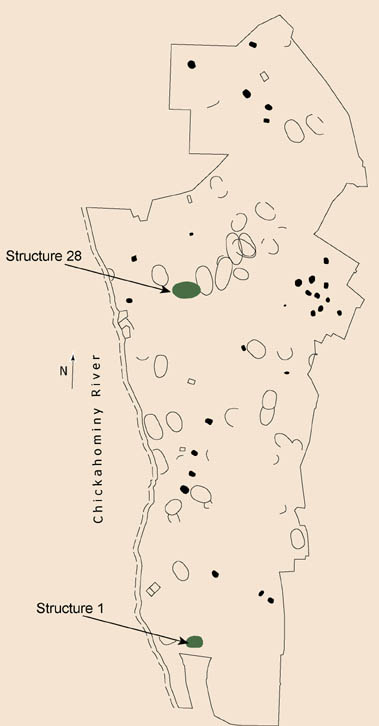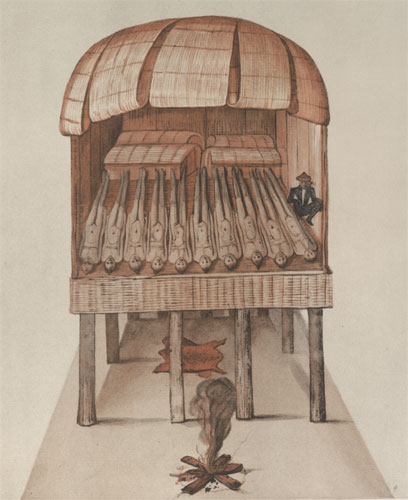
 |
| Overview | Site Context | Examine the Site | Timeline |
Understanding Native American StructuresMortuary HousesBased on their location within 44JC308, Structures 1 and 28 may be mortuary houses. Mortuary houses or temples were the final resting places of Powhatan leaders, who, after death, were "disemboweled and then placed on a scaffold…for decomposing" (Rountree 1989:113) along with a variety of offerings. Sometime later the flesh was scraped off the bones and still later the bones were gathered into a bundle or laid out, wrapped in mats and skins, and kept in the chiefdom's main temple. According to the Harriot text, White's watercolor (below) of a North Carolina Algonquian tomb depicts the leather-wrapped bones of nine werowances, laid atop a scaffold and fashioned to look as they did in life. Although evidence of scaffolding is not apparent in their postmold patterns, the orientation and location of Structures 1 and 28 support the inference that they are mortuary houses or temples. First, unlike the rest of the buildings, Structures 1 and 28 are oriented east-west, corresponding to Strachey's (1953:88-89) description of these unique buildings. An east-west orientation may have been vital to the westward journey chiefs were believed to take in the afterlife (Rountree 1989:139) and corresponds to the east-west orientation of the extended burials excavated at the site.. (Find quote in Strachey or Smith). Secondly, both structures are found in positions that correspond to likely temple locations. Structure 1 is found on the margins of the site, comparable to the mortuary house of Secotan. Structure 28, in contrast, is located in the midst of buildings that based on their size and interior features are believed to have been inhabited by the village leader or werowance, where they could have fulfilled their dual role as mortuary house and chief's storehouse, as described by Strachey (1953:88-89). Perhaps Structure 1, at the edge of the site, was where decomposing bodies were located, while Structure 28 was a storehouse for the bone bundles of previous chiefs. |

The green areas indicate the possible locations of mortuary houses. |

Portion of watercolor drawing "Indian Charnal House" by John White (created 1585-1586). Licensed by the Trustees of the British Museum. ©Copyright the British Museum. |
 See this house in relation to other buildings in the village (the house is in the lower left corner and is shaded yellow). This image is a section of "The Tovvne of Secotan" an engraving by Theodor De Bry (printed 1590) based on watercolor by John White. (Courtesy of the John Carter Brown Library at Brown University.) |